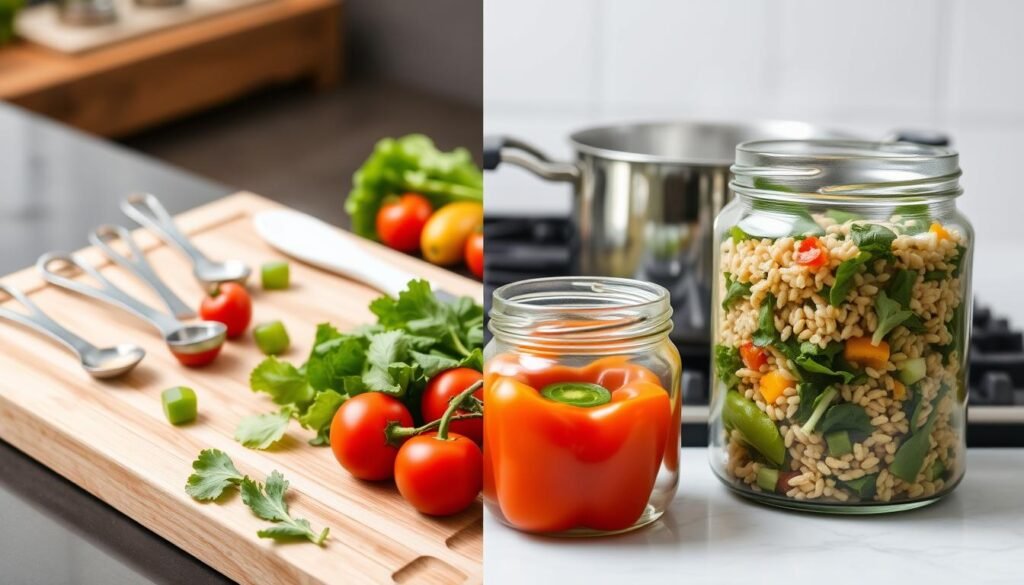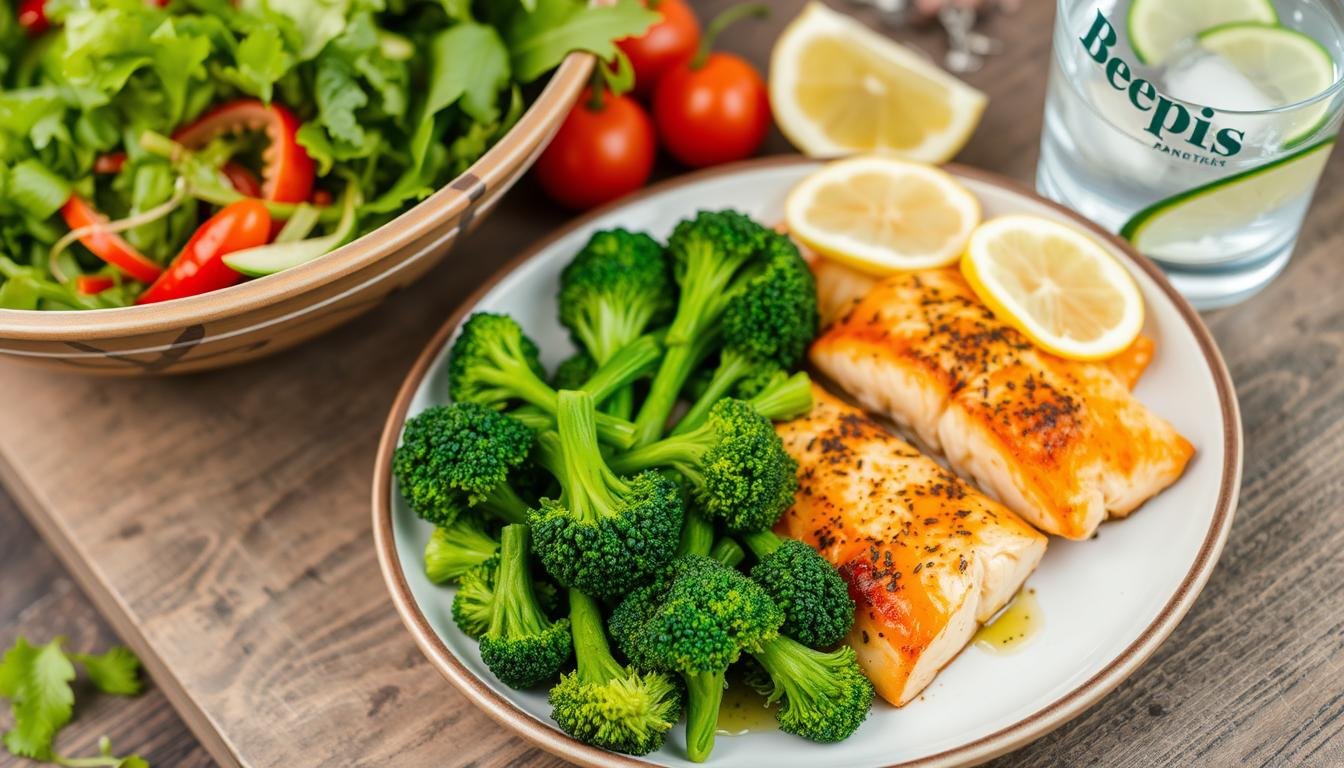Exploring low-calorie meals can change how you view food and health. These dishes are tasty and help you stay healthy. Most meals have 232 to 488 calories, making them perfect for a balanced diet.
Low-calorie meals are great for those who want to eat well and stay fit. Learning about nutritious cooking lets you make meals that are good for you and delicious.
Key Takeaways
- Low-calorie meals typically contain 500 calories or less per serving
- Nutritious meals can be both delicious and health-conscious
- Variety is key to maintaining an enjoyable low-calorie diet
- Portion control plays a crucial role in calorie management
- Whole foods are fundamental to creating satisfying low-calorie meals
What Are Low-Calorie Meals?
Exploring light eating means understanding low-calorie meals. These meals are made to give you lots of nutrition but not too many calories.
Defining Low-Calorie Meals
A low-calorie meal has 200-400 calories. It uses ingredients that are good for you. It’s not about cutting out food, but choosing the right ones.
- Lean proteins (chicken, fish)
- Non-starchy vegetables
- Complex carbohydrates
- Minimal added fats
Balanced Diet Integration
Portion control is key to a balanced diet. Your focus should be on quality, not quantity. A grilled chicken breast with roasted veggies is a perfect example.
“Eating smart is about making every calorie count” – Nutrition Experts
Planning your meals is important. It lets you eat fewer calories but still get the nutrients you need. Choosing foods that are filling but low in calories helps you stay healthy.
Benefits of Eating Low-Calorie Meals
Discovering the power of nutritious meals can change how you eat and manage your weight. Low-calorie meals help you reach your health and fitness goals. They also nourish your body.
Weight Management Strategies
Slimming meals are key for controlling weight. Studies show losing weight is possible by eating fewer calories. It’s important to eat foods rich in nutrients but with fewer calories.
- Reduce daily calorie intake to 1,200-1,500 calories
- Focus on whole, unprocessed foods
- Track nutritional content and portion sizes
Nutrition Powerhouse
Clean eating with low-calorie meals gives you lots of nutrients. The CDC says a nutrient-rich diet has many health benefits:
| Nutritional Benefit | Impact |
|---|---|
| Immune System Support | Strengthens body’s natural defenses |
| Disease Prevention | Reduces risk of type 2 diabetes and heart disease |
| Overall Wellness | Improves skin, eye, and dental health |
Energy Level Boost
Your body needs good, consistent nutrition. Low-calorie meals give you steady energy. Think of food as fuel for your daily performance.
“Nutrition is not about being perfect. It’s about eating food that makes you feel great.” – Unknown
Planning your meals well helps keep your energy up. It also supports your health and weight goals. Remember, the quality of calories is as important as the amount.
Tips for Creating Low-Calorie Meals
Making tasty, low-calorie meals is all about smart strategies. These help make your meals both filling and healthy. Changing how you prepare meals can turn healthy eating into a fun activity.

Portion Control Strategies
It’s key to control your meal sizes for a healthy diet. Here are some tips:
- Use smaller plates to naturally reduce portion sizes
- Measure ingredients with kitchen scales or measuring cups
- Fill half your plate with vegetables
- Practice mindful eating by eating slowly
Smart Ingredient Substitutions
Upgrade your meals by swapping high-calorie ingredients for healthier ones. Try using Greek yogurt instead of sour cream or applesauce in place of oil when baking.
| Original Ingredient | Low-Calorie Substitute | Calorie Reduction |
|---|---|---|
| Sour Cream | Greek Yogurt | Up to 50% |
| Butter | Mashed Avocado | 40% |
| White Rice | Cauliflower Rice | 70% |
Cooking Techniques for Low-Calorie Meals
Choose cooking methods that boost flavor without adding too many calories:
- Grilling lean proteins
- Steaming vegetables
- Roasting with minimal oil
- Air frying for crispy textures
“Healthy cooking isn’t about deprivation, it’s about smart, delicious choices.”
By using these tips, you’ll make meals that are both filling and healthy.
Popular Low-Calorie Ingredients
Starting with the right ingredients is key to making tasty, healthy meals. Knowing which foods are low in calories but rich in nutrients is important for your health.
Vegetables and Fruits: Nutrient Powerhouses
Non-starchy vegetables are great for low-calorie, nutrient-packed meals. Here are some colorful options:
- Leafy greens like spinach and kale
- Broccoli and cauliflower
- Bell peppers in various colors
- Zucchini and cucumber
Lean Proteins: Satisfying and Nutritious
Protein keeps you full and supports muscle health. Here are some low-calorie protein sources:
| Protein Source | Calories per Serving | Protein Content |
|---|---|---|
| Grilled Chicken Breast | 127 | 23g |
| Cooked Salmon | 193 | 20g |
| Tofu | 94 | 10g |
Whole Grains: Fiber-Rich Foundations
Whole grains are full of nutrients and help keep your diet balanced. Here are some low-calorie options:
- Quinoa: Complete protein with fiber
- Brown rice: Nutrient-dense alternative
- Oats: Versatile and filling
“Eating clean isn’t about perfection, it’s about making better choices most of the time.” – Unknown
By using these ingredients, you’ll make delicious, healthy meals that support your health and wellness goals.
Easy Low-Calorie Meal Ideas
Discovering tasty diet-friendly dishes is easy. These healthy recipes let you enjoy full meals without the extra calories. Your taste buds will thank you.
Breakfast Options to Kickstart Your Day
Begin your day with nutritious, low-calorie breakfasts. They give you energy without feeling heavy:
- Greek Yogurt Parfait (254 calories)
- Spinach and Egg White Frittata (199 calories)
- Overnight Oats with Fresh Berries (227 calories)
Lunch Recipes for Midday Nutrition
Make your lunchtime meals both filling and light with these diet-friendly dishes:
| Meal | Calories | Protein |
|---|---|---|
| Chicken & Cauliflower Rice Bowl | 227 | 28g |
| Halibut Taco with Mango Salsa | 330 | 28g |
| Spinach Shrimp Fettuccine | 283 | 17g |
Dinner Inspirations for Satisfying Meals
Finish your day with these healthy recipes. They show that low-calorie meals can be both tasty and good for you:
“Eating well is not about deprivation, it’s about making smart, flavorful choices.”
- Rosemary Salmon with Roasted Vegetables (357 calories)
- Crunchy Chili Lime Shrimp (230 calories)
- Ginger Halibut with Brussels Sprouts (234 calories)
These meal ideas show that diet-friendly dishes can be exciting and varied. With the right ingredients and creative cooking, you can enjoy meals that are both healthy and delicious.
Meal Planning for Low-Calorie Success

Starting a weight-conscious diet begins with meal planning. Spend time planning your meals for the week. This change can improve your eating habits and help you reach your health goals.
Smart Weekly Planning Strategies
Good meal planning needs careful thought. Here are some tips for cooking with fewer calories:
- Set aside 1-2 hours each week for meal preparation
- Create a rotating menu of low-calorie favorites
- Prep ingredients in advance to save time
- Use portion control containers for easy measurement
Essential Grocery List Items
Keep your kitchen stocked with these healthy, low-calorie foods:
- Fresh vegetables (spinach, broccoli, carrots)
- Lean proteins (chicken breast, fish, tofu)
- Whole grains (quinoa, brown rice)
- Healthy condiments and spices
“Planning is bringing the future into the present so you can do something about it now.” – Alan Lakein
For a diet focused on weight loss, tracking calories is key. A 500-calorie cut each day can result in losing about 1 pound a week. With smart meal planning, you can make healthy eating easier and keep it consistent.
Batch Cooking Techniques
Improve your meal prep with these batch cooking tips:
- Prepare large batches of proteins and grains
- Utilize freezer-friendly containers
- Rotate meals to prevent boredom
- Store individual portions for quick access
Low-Calorie Snack Options
Discovering tasty light eating strategies can change how you snack. Choosing smart snacks helps control hunger and keeps calories low.
Healthy Snack Choices
When picking low-calorie snacks, go for ones that are full of nutrients. Look for snacks that are both healthy and delicious.
- Fresh fruit with a small serving of nuts
- Vegetable sticks with hummus
- Air-popped popcorn
- Greek yogurt with berries
Quick and Easy Preparations
Nutritious meals don’t need to be hard to make. Here are some quick snack ideas:
| Snack Option | Calories | Preparation Time |
|---|---|---|
| Baby carrots with hummus | 100 calories | 2 minutes |
| Apple slices with peanut butter | 90 calories | 3 minutes |
| Edamame | 100 calories | 5 minutes |
| Greek yogurt with berries | 84 calories | 1 minute |
“Snacking smart is about quality, not quantity.” – Nutrition Expert
Remember, light eating is about making choices that are good for your body. It keeps you energized between meals.
Common Myths About Low-Calorie Meals
Finding your way through diet-friendly dishes can be tough with all the wrong information out there. It’s important to know the truth about healthy recipes and eating fewer calories. This knowledge helps you make better food choices.
Debunking Nutritional Misconceptions
Many think low-calorie meals are boring and don’t fill you up. But research proves this is not true. The secret is in how you prepare your food and knowing how to balance nutrients.
- Myth: Low-calorie foods are always tasteless
- Myth: You can’t feel full on a low-calorie diet
- Myth: All low-calorie options are inherently healthy
The Reality of Calorie Calculations
It’s surprising, but calorie counts can be off. The FDA lets food makers have up to 20% error on labels. A study in Obesity found some packaged meals have 8% more calories than they say.
“A decrease of 10 calories per day could lead to a one-pound loss, potentially taking up to three years to achieve” – Carson C. Chow, PhD
Understanding Satiety
| Satiety Factor | Impact on Fullness |
|---|---|
| Protein Content | Increases feeling of fullness |
| Fiber Intake | Slows digestion, promotes satisfaction |
| Meal Volume | Contributes to perceived fullness |
Making diet-friendly dishes isn’t about cutting out everything. It’s about making meals that are full of nutrients and keep you feeling good. This way, you support your health goals without feeling deprived.
Smart Eating Strategies
- Focus on whole, unprocessed foods
- Include adequate protein in meals
- Practice portion control
- Listen to your body’s hunger signals
Remember, good nutrition is about finding a balance, not being perfect. Enjoying your diet should be part of the journey. It’s about nourishing your body in a way that feels good.
Incorporating Low-Calorie Meals Into Your Lifestyle
Creating lasting clean eating habits is more than picking slimming meals. It’s about making nutrition a part of your everyday life. The goal is to find a balance that feeds your body and keeps your health goals in sight.
Mindful Eating Practices
Mindful eating changes how you view food. Begin with intentional consumption. This means:
- Eating slowly and without digital distractions
- Paying attention to hunger and fullness signals
- Savoring each bite of your low-calorie meal
“Eat with intention, not just habit.”
Finding Balance
Slender meals don’t mean cutting out food completely. Balance is key in clean eating. Here are some tips:
| Strategy | Approach |
|---|---|
| Social Eating | Choose wisely, portion control |
| Special Occasions | Enjoy mindfully, return to routine |
| Activity Adjustment | Modify calories based on exercise |
Remember, lasting nutrition is about being consistent, not perfect. Your path to better eating is unique and adaptable.
Resources for Further Guidance
Exploring low-calorie eating can seem daunting. But, many resources are available to guide you. You can find healthy recipes and diet-friendly dishes with ease. The trick is to find what fits your health goals and lifestyle.
Cookbook Recommendations
Quality cookbooks can change how you plan meals. Look for ones with science-based nutrition guidance and tasty, low-calorie recipes. Books that offer detailed nutrition info and creative cooking tips make healthy eating fun and lasting.
Digital Support and Planning
Online meal planning tools have changed diet management. They offer custom meal plans, grocery lists, and tracking. With 70% of people looking for calorie info, these tools are key for smart food choices.
Community Connections
Joining others who share your healthy eating goals can be a game-changer. Online forums, social media groups, and local meetups are great for support and recipe sharing. Studies show community support boosts sticking to dietary plans, making your journey more enjoyable and lasting.

